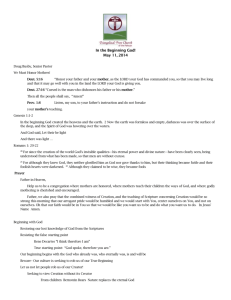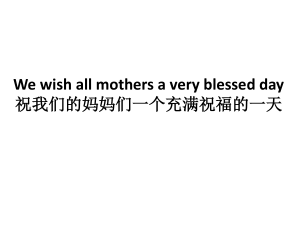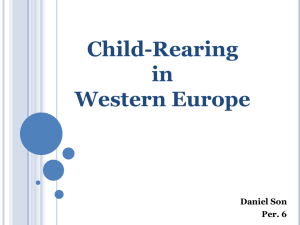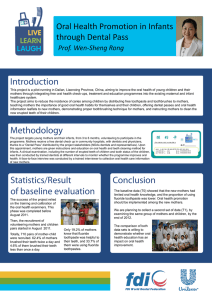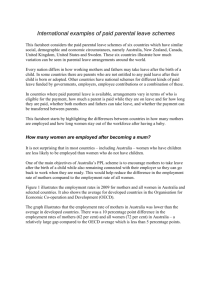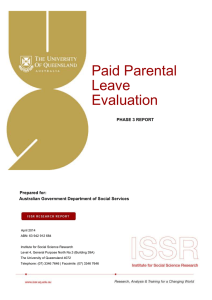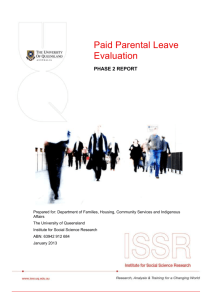Paid Parental Leave evaluation – Phase One (baseline) findings
advertisement
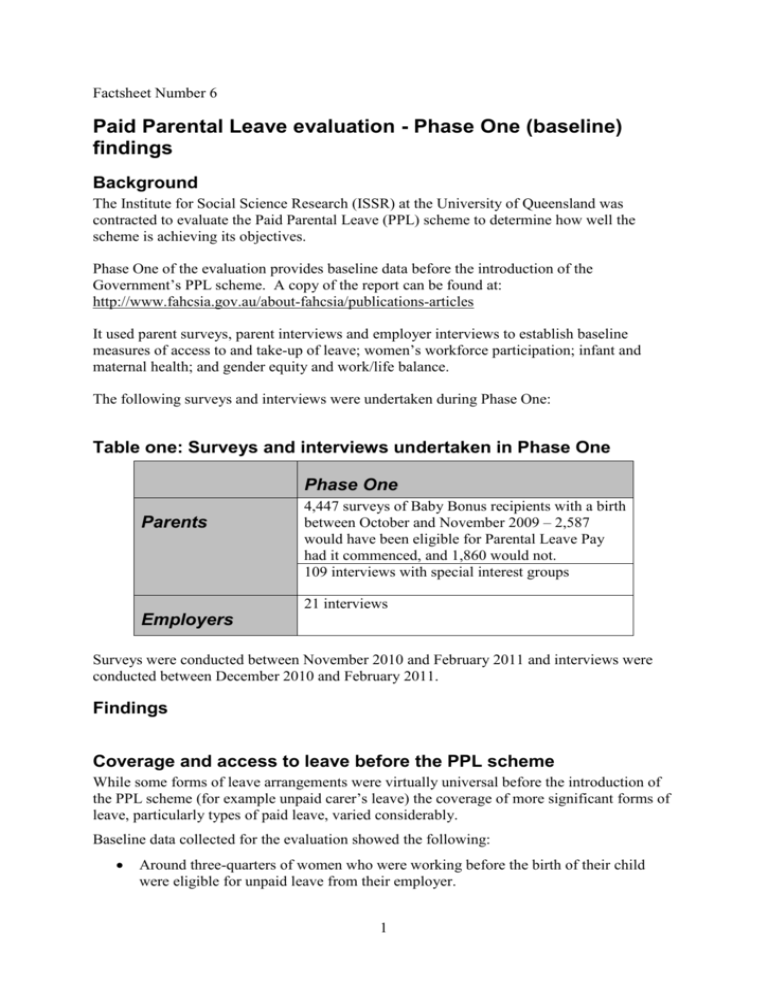
Factsheet Number 6 Paid Parental Leave evaluation - Phase One (baseline) findings Background The Institute for Social Science Research (ISSR) at the University of Queensland was contracted to evaluate the Paid Parental Leave (PPL) scheme to determine how well the scheme is achieving its objectives. Phase One of the evaluation provides baseline data before the introduction of the Government’s PPL scheme. A copy of the report can be found at: http://www.fahcsia.gov.au/about-fahcsia/publications-articles It used parent surveys, parent interviews and employer interviews to establish baseline measures of access to and take-up of leave; women’s workforce participation; infant and maternal health; and gender equity and work/life balance. The following surveys and interviews were undertaken during Phase One: Table one: Surveys and interviews undertaken in Phase One Phase One Parents 4,447 surveys of Baby Bonus recipients with a birth between October and November 2009 – 2,587 would have been eligible for Parental Leave Pay had it commenced, and 1,860 would not. 109 interviews with special interest groups 21 interviews Employers Surveys were conducted between November 2010 and February 2011 and interviews were conducted between December 2010 and February 2011. Findings Coverage and access to leave before the PPL scheme While some forms of leave arrangements were virtually universal before the introduction of the PPL scheme (for example unpaid carer’s leave) the coverage of more significant forms of leave, particularly types of paid leave, varied considerably. Baseline data collected for the evaluation showed the following: Around three-quarters of women who were working before the birth of their child were eligible for unpaid leave from their employer. 1 Just over half of the women who were working before the birth of their child had access to employer-paid maternity leave. Of those who were eligible almost all of them took paid leave. Access to paid leave varied depending on: o the size of the organisation, where women in larger size organisations were much more likely to have access o the type of contract, where women on permanent or ongoing contracts were much more likely to have access. The introduction of the government PPL scheme is likely to extend coverage of paid parental leave from 51 per cent of working women to 95 per cent. About 5 per cent of women and 12 per cent of single mothers who would have been eligible for the government PPL scheme, would not be eligible for unpaid leave from their employer. Qualitative interviews showed that some women who were in a position to do so, changed employers to improve their access to leave and flexible work arrangements before the birth of their baby. Mothers’ labour force participation The Productivity Commission estimated that the PPL scheme they proposed would extend the average Australian women’s lifetime period of employment by between two and six months. Relevant findings from the PPL baseline evaluation are: A majority of mothers who would have been eligible for Parental Leave Pay had returned to work by the time their baby was 13 months old. Of these mothers: o The average age of their babies upon their return to work was 6.7 months. o Three quarters returned to work in the same job they held before the baby’s birth. Two thirds of women who returned to work agreed with the statement that they returned to work earlier than they would have liked because “I/we needed the money”. Women employed on different types of employment contracts showed distinctive return to work patterns: thirteen months after the birth of their babies self employed mothers were the most likely to have returned to work, followed by mothers with permanent jobs and then mothers engaged in casual employment. Single mothers were less likely to return to work than other mothers. However, when single mothers did return to work, they did so when their babies were younger than average (5.9 months compared to 6.7 months for other mothers). Maternal and infant health and wellbeing In general there was little or no association between leave taking or return to work patterns, and mothers’ experiences of a variety of health issues that are widely viewed as key indicators of general health. Most mothers rated their current health as “good” or better. 2 The most widespread health concerns were tiredness, fatigue and in some cases exhaustion. Almost all women referred to these concerns. Most mothers perceived that leave taking and return to work patterns are not significantly associated with child health outcomes. Almost all mothers assessed their child’s health as “good”, “very good” or “excellent”, with less than 2 per cent regarding it as “fair” or “poor”. Overall, whether or not mothers had access to paid leave had little impact on whether or not their babies were breastfed, though it had a small impact on the length of time they were breastfed. The rate of breastfeeding initiation was high and did not vary significantly based on whether the mother had paid leave or with length of paid leave. The average number of weeks that children were breastfed was 24 weeks. o Women with no paid leave breastfed for the shortest average period of around 22 weeks, and those still on leave at the time of the survey breastfed for an average of nearly 25 weeks. Gender equality and work-life balance Women perform the majority of all household work activities. More than half of the women surveyed reported ‘always’ or ‘often’, feeling rushed or pressed for time. Women who had not returned to work were less likely to report time pressures than women who had returned to work. 3



